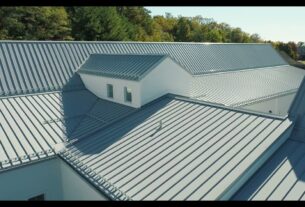In the realm of real estate, every detail matters. From curb appeal to interior finishes, every aspect of a property contributes to its overall value. Yet, the roof is one overlooked component that significantly influences property worth. A roofing quality, condition, and material can profoundly impact a property’s value and marketability.
According to remodeling.hw.net, homeowners can expect to recover almost 61% of the cost of a new asphalt roof. This makes roofing replacement one of the most valuable investments in a property. This also shows how a new-looking, well-maintained roof can drive a property’s value.
The Importance of Roofing Quality
The importance of roofing quality cannot be overstated when considering a structure’s overall integrity and durability. A roof serves as the primary defense, protecting the interior of a building from rain, snow, wind, and harsh sunlight. A well-constructed roof enhances a property’s aesthetic appeal and ensures its occupants’ safety and comfort.
One of the key aspects of roofing quality is the choice of materials. High-quality roofing materials such as asphalt shingles, metal roofing, clay tiles, or slate offer superior durability and longevity compared to cheaper alternatives. Investing in premium materials may require a higher initial cost but pays off in the long run.
Proper installation is another crucial factor in ensuring roofing quality. Even the best materials can fail if they are not installed correctly. A skilled and experienced roofing contractor understands the importance of precise installation techniques, including proper flashing, sealing, and ventilation. Attention to detail during the installation minimizes the risk of leaks, water damage, and structural issues.
Curb Appeal and First Impressions
Curb appeal plays a vital role in driving a property’s value. As stated by Explore The Pearl, curb appeal makes up around 7% of the selling price of a property. It can even go as high as 14% in some cases.
Similarly, the curb appeal of a roof plays a significant role in shaping the overall aesthetic of a property. When potential buyers or visitors approach a house, one of the first elements they notice is the roof. A well-maintained and visually appealing roof enhances the attractiveness of the entire property and creates a positive first impression.
A roof that complements the house’s architectural style and blends harmoniously with its surroundings attracts more attention and admiration. Conversely, a roof that appears outdated, worn, or in disrepair can detract from the property’s appeal and raise concerns about its structural integrity.
Therefore, Peak Builders Orange County states that maintaining and repairing roofing is vital. You can prevent minor problems from escalating into more significant and costly issues by addressing issues promptly and ensuring regular upkeep. Regular roof inspections help identify potential leaks, damaged shingles, or deteriorating flashing. Addressing these issues promptly can prevent water damage, mold growth, and structural issues within the property.
It is also crucial to get these repairs done by professionals. You might think you should be able to do DIY roofing repairs without hassle. However, professionals will have the right tools and expertise to ensure optimal repair for the roof’s longevity and durability. Therefore, you should always try to hire professional roofing repair services.
Long-Term Cost Savings
Roofing quality is pivotal in ensuring long-term cost savings for homeowners and businesses. A high-quality roof protects against the elements, including rain, wind, snow, and sunlight. Property owners can mitigate the risk of costly repairs and replacements down the line by investing in premium materials and skilled installation.
One of the primary ways roofing quality contributes to long-term cost savings is by reducing the frequency and extent of maintenance. A well-constructed roof with top-grade materials is less prone to damage and wear, requiring fewer repairs over its lifespan. This translates to lower maintenance expenses and less repair downtime, allowing property owners to allocate resources more efficiently.
Furthermore, a high-quality roof enhances energy efficiency by providing better insulation and ventilation. Proper insulation helps regulate indoor temperatures, reducing the strain on heating and cooling systems throughout the year. Property owners can significantly lower their utility bills over time by minimizing energy consumption, resulting in substantial cost savings.
Energy Efficiency and Sustainability
One of the key ways roofing quality improves energy efficiency is through effective insulation. A high-quality roof incorporates insulation materials that minimize heat transfer between the interior and exterior of the building. This reduces the need for excessive heating or cooling, thus lowering energy usage and associated greenhouse gas emissions.
Moreover, quality roofing materials and construction techniques contribute to better moisture management. A durable roof helps maintain indoor air quality by preventing water infiltration and accumulation. It prevents the growth of mold and mildew, which can pose health risks and degrade building materials over time.
In addition, a well-maintained roof with proper ventilation systems can enhance passive cooling and airflow within the building. This reduces reliance on mechanical cooling systems during hot weather, reducing energy consumption and utility costs while promoting occupant comfort.
Roofing materials also are important for energy efficiency and sustainability. For example, bamboo roofs or the ones made with recycled materials are good for the environment. Similarly, you can save almost 20-30% if you go for metal roofs, according to EcoWatch.
Factors Influencing Roofing Choices
When considering roofing choices, several factors come into play, influencing decisions on materials, styles, and installation methods. One of the primary considerations is climate. Different roofing materials perform better in specific climates.
For instance, homeowners may opt for asphalt shingles or metal roofing that can withstand moisture and weight in regions with heavy rainfall. In contrast, in hot climates, materials with reflective properties, such as clay tiles or metal roofs, might be preferred to help keep interiors cooler.
Cost is another crucial factor. The initial cost of materials and installation, as well as long-term maintenance expenses, influence roofing choices. For instance, materials like asphalt shingles are more affordable upfront. According to a Forbes article, basic asphalt shingles cost between $4.25 and $8.25 per square foot, including installation. However, they may require more frequent repairs and replacements than higher-end options like slate or tile roofs, which have greater longevity.
Aesthetic preferences also play a significant role in roofing decisions. Homeowners often seek roofing materials and styles that complement their homes’ architectural style and enhance curb appeal. Factors such as color, texture, and profile contribute to the overall appearance of the roof and its integration with the rest of the structure.
In conclusion, the roof is a cornerstone of property value, significantly influencing marketability, energy efficiency, and long-term cost savings. Investing in high-quality roofing solutions enhances the property’s aesthetic and curb appeal and contributes to its structural integrity and sustainability. Property owners prioritizing roofing quality reap the rewards of enhanced marketability, resale value, and overall satisfaction.




